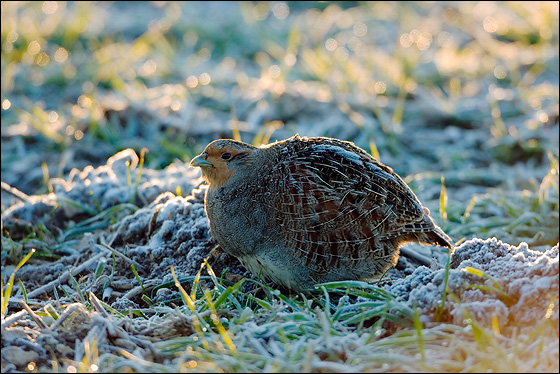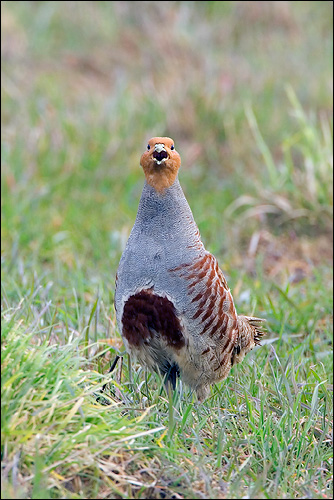Grey Partridge (Perdix perdix)
Measurements: 29-31cm long.
Id: Slightly smaller than Red-legged and other partridges. Orange throat without black border diagnostic. Large, heart-shaped breast spot more extensive on male than on female.
Ground-hugging in the extreme, the Grey Partridge is not very keen on flying. If it needs to move around, it goes on foot. If danger threatens, it will walk away or run, taking flight only when a predator is gaining. A pair was once observed for 15 hours continuously, and in that period only flew four times, covering just 180m in the process.
Surprisingly, though, these birds are not particularly bad at using their wings. In the extreme east of their European range they are partial migrants, moving south for the winter and becoming nomadic for a few months. They move at dusk and dawn, and can cover up to 470km in their annual journey. The deciding factor in migration is snow cover. If it lies for more than five months of the year, or is more than 50cm deep for over a month, the birds are forced to move out.
The natural habitat of the Grey Partridge is grassland, ideally just tall enough to cover the birds themselves. Within this broad habitat Grey Partridges also need patches of taller, thicker vegetation in which to nest, and some open earth to indulge in one of their favourite activities, dust-bathing. Suitable grassland is a rare commodity in Europe nowadays, but farmland can make an acceptable substitute, and most Grey Partridges are found in agricultural areas.
Pair-formation begins in February when flocks split up. Females stay put on their winter home range, while young males wander in search of a mate (the reverse of the arrangement in Red-legged Partridges). Courtship is initiated by the female, who approaches the male with head down and makes for his flank stripes, seeming to peer at them very closely. She then passes her bill over the flanks and back, without touching the male, and circles him. The male, meanwhile, stands proud and erect, its neck fluffed out and its large belly patch prominent.
For a nest the female makes a shallow depression under a hedge or thicket and lines it with a few bits of vegetation. She then proceeds to lay a remarkably large number of eggs, usually between 10 and 20 in all. The average clutch size, which can reach 18 in the north of the Grey Partridge’s range, is the highest for any bird in Europe, and perhaps the world. The record is 29.
When the chicks hatch, both parents attend them and move them around in search of insects, which constitute their primary diet (up to 90%) for the first two weeks of their lives. Aphids and various beetles are taken, along with a large number of the larvae of sawflies, which are found on the leaves of cereal crops. Later on the diet will change considerably, for the Grey Partridge is largely a vegetarian. In autumn and winter the birds eat the leaves of grasses, cereals and clover, mixed in with some weed seeds, of which the favourite appears to be knotgrass (Polygonum). The following spring they switch to the seed-heads of chickweed (Stellaria) and unripe grass seeds.
After the breeding season the whole family remains together to form a flock known as a covey, and this unit may be joined by a few unpaired birds, or perhaps another family. At night all birds sleep in a rough circle with their heads pointing out and tails in; if flushed to flight, the covey usually remains together, whereas Red-legged Partridges in the same circumstances often fly off in different directions.
From ‘Birds: A Complete Guide to All British and European Species’, by Dominic Couzens. Published by Collins and reproduced with permission.


